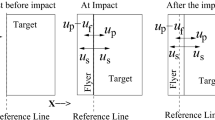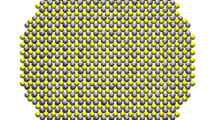Abstract
Silicon carbide ceramics under shock loading is an important aspect in studying their physical and mechanical properties. Molecular dynamics simulations have been carried out using Tersoff-1989, Tersoff-1994, Tersoff-2005 and Vashishta potentials, respectively. The Hugoniot states including compression stress, shear stress, temperature and shock wave velocity are calculated, as well as shock-induced plasticity and the shock wave fronts. A comprehensive comparison among different potentials, as well as comparison to current available experiments, has been made. Tersoff-1989, Tersoff-1994 and Tersoff-2005 potentials are easily to overestimate the shock stress, shear stress and temperature, as well as shock wave velocity, while Vashishta potential shows excellent agreement with experimental data. The Hugoniot elastic limit is ~ 14.5 GPa and the maximum shear stress is ~ 6 GPa using Vashishta potential which are in good agreement with experiments, while Tersoff-like potentials yield much higher values. Due to differences in radial distribution function among these potentials, Vashishta potential is prone to produce plasticity and structural phase transformation basing on the statistics of the coordination numbers of atoms. Besides, the shock wave fronts show little difference among these potentials under elastic shock compression at low particle velocity. However, when it comes to high shock intensity resulting in plasticity or phase transition, the Tersoff-1989 and Tersoff-1994 produce the widest shock wave fronts, followed by Tersoff-2005, while Vashishta potential has the narrowest wave front. By comprehensive comparisons, the Vashishta potential is demonstrated to be the most suitable one to describe the silicon carbides ceramics under shock loadings. Our work provides useful information to select a suitable potential to study the shock response of silicon carbides ceramics using molecular dynamics simulations.










Similar content being viewed by others
References
Hsu SM, Shen M (2004) Wear prediction of ceramics. Wear 256:867
Weitzel CE, Palmour JW, Carter CH, Moore K, Nordquist KJ, Allen S, Thero C, Bhatnagar M (1996) Silicon carbide high-power devices. IEEE Trans Electron Devices 43:10
Gooh WA (2001) In: McCauley JW et al (eds) Ceramic armor materials. The American Ceramic Society, Weaterivlle, pp 3–21
Hogg PJ (2006) Composites in armor. Science 314:1100
Drolshagen G (2008) Impact effects from small size meteoroids and space debris. Adv Space Res 41:1123–1131
Mcbride N, McDonnell JAM (1999) Meteoroid impacts on spacecraft: sporadics, streams, and the 1999 Leonids. Planet Space Sci 47:1005–1013
Christiansen EL, Hyde JL, Bernhard RP (2004) Space shuttle debris and meteoroid impacts. Adv Space Res 34:1097–1103
Feng R, Raiser GF, Gupta YM (1996) Shock response of polycrystalline silicon carbide undergoing inelastic deformation. J Appl Phys 79(3):1378–1387
Feng R, Raiser GF, Gupta YM (1998) Material strength and inelastic deformation of silicon carbide under shock wave compression. J Appl Phys 83(1):79–86
Yuan G, Feng R, Gupta YM (2001) Compression and shear wave measurements to characterize the shocked state in silicon carbide. J Appl Phys 89(10):5372–5380
Grady DE (1998) Shock-wave compression of brittle solids. Mech Mater 29:181–203
Shih CJ, Meyers MA, Nesterenko VF (1998) High-strain-rate deformation of granular silicon carbide. Acta Mater 46(11):4037–4065
Sarva S, Nemat-Nasser S (2001) Dynamic compressive strength of silicon carbide under uniaxial compression. Mater Sci Eng A 317:140–144
Wang H, Ramesh KT (2004) Dynamic strength and fragmentation of hot-pressed silicon carbide under uniaxial compression. Acta Mater 52(2):355–367
Vogler TJ, Reinhart WD, Chhabildas LC, Dandekar DP (2006) Hugoniot and strength behavior of silicon carbide. J Appl Phys 99(2):023512
Millett JCF, Bourne NK, Dandekar DP (2005) Delayed failure in a shock-loaded silicon carbide. J Appl Phys 97(11):113513
Paris V, Frage N, Dariel MP, Zaretsky E (2010) The spall strength of silicon carbide and boron carbide ceramics processed by spark plasma sintering. Int J Impact Eng 37(11):1092–1099
Anderson CE, Behner T, Holmquist TJ, Orphal DL (2011) Penetration response of silicon carbide as a function of impact velocity. Int J Impact Eng 38(11):892–899
Zhu HY, Ma YZ, Yang HB, Selvi E, Hou DB, Ji C (2008) Synthesis and compression of nanocrystalline silicon carbide. J Appl Phys 104(12):123516
Zou JH, Ye ZQ, Cao BY (2016) Phonon thermal properties of graphene from molecular dynamics using different potentials. J Chem Phys 145(13):134705
de Tomas C, Suarez-Martinez I, Marks NA (2016) Graphitization of amorphous carbons: a comparative study of interatomic potentials. Carbon 109:681–693
Dziedzic J, Winczewski S, Rybicki J (2016) Structure and properties of liquid Al–Cu alloys: empirical potentials compared. Comput Mater Sci 114:219–232
Hao JN, Shu XL, Jin S, Zhang XS, Zhang Y, Lu GH (2017) A comparison of interatomic potentials for modeling tungsten nanocluster structures. Nucl Instrum Methods Phys Res Sect B Beam Interact Mater Atoms 393:180–185
Kanski M, Maciazek D, Golumski M, Postawa Z (2017) Sputtering of octatetraene by 15 keV C60 projectiles: comparison of reactive interatomic potentials. Nucl Instrum Methods Phys Res Sect B Beam Interact Mater Atoms 393:29–33
Tersoff J (1989) Modeling solid-state chemistry: interatomic potentials for multicomponent systems. Phys Rev B 39(8):5566
Tersoff J (1990) Carbon defects and defect reactions in silicon. Phys Rev Lett 64(15):1757
Tersoff J (1994) Chemical order in amorphous silicon carbide. Phys Rev B 49(23):16349
Makeev Maxim A, Srivastava Deepak (2006) Silicon carbide nanowires under external loads: an atomistic simulation study. Phys Rev B 74:165303
Makeev Maxim A, Sundaresh Suman, Srivastava Deepak (2009) Shock-wave propagation through pristine a-SiC and carbon-nanotube-reinforced a-SiC matrix composites. J Appl Phys 106:014311
Bringuier S, Manga VR, Runge K, Deymier P, Muralidharan K (2015) Grain boundary dynamics of SiC bicrystals under shear deformation. Mater Sci Eng, A 634:161–166
Lee WH, Yao XH, Jian WR, Han Q (2015) High-velocity shock compression of SiC via molecular dynamics simulation. Comput Mater Sci 98:297–303
Devanathan R, Diaz de la Rubia T, Weber WJ (1998) J Nucl Mater 253:47
Erhart P, Albe K (2005) Analytical potential for atomistic simulations of silicon, carbon, and silicon carbide. Phys Rev B 71(3):035211
Vashishta P et al (2007) Interaction potential for silicon carbide: a molecular dynamics study of elastic constants and vibrational density of states for crystalline and amorphous silicon carbide. J Appl Phys 101(10):103515
Tsuzuki H, Rino JP, Branicio PS (2011) Dynamic behaviour of silicon carbide nanowires under high and extreme strain rates: a molecular dynamics study. J Phys D Appl Phys 44:055405 (8pp)
Branicio PS, Kalia RK, Nakano A, Vashishta P (2010) Nanoductility induced brittle fracture in shocked high performance ceramics. Appl Phys Lett 97:111903
Zhang J, Branicio PS (2014) Molecular dynamics simulations of plane shock loading in SiC. Procedia Eng 75:150–153
Li WH, Yao XH (2016) The spall of single crystal SiC: the effects of shock pulse duration. Computat Mater Sci 124:151–159
Li WH, Yao XH, Branicio PS (2017) X, Q, Zhang and N. B. Zhang, Shock-induced spall in single and nanocrystalline SiC. Acta Mater 140:274–289
Plimpton SJ (1995) Fast parallel algorithms for short-range molecular dynamics. J Comput Phys 117:1–19. http://lammps.sandia.gov/
Weisstein EW Voronoi diagram. from MathWorld–a wolfram web resource. http://mathworld.wolfram.com/VoronoiDiagram.html
Marsh SP (1980) LSAL shock hugoniot data. University of California Press, Berkeley
Yosida M, Onodera A, Ueno M, Takemura K, Shimomura O (1993) Pressure-induced phase transition in SiC. Phys Rev B 48:10587
Shimojo F, Ebbsjo I, Kalia RK, Nakano A, Rino JP, Vashishta P (2000) Molecular dynamics simulation of structural transformation in silicon carbide under pressure. Phys Rev Lett 84:15
Acknowledgements
This study was funded by Natural Science Foundation of China (Grant Numbers: 11372113, 11472110 and 11672110), Guangdong Provincial Education Department, innovation and strong school funding (Grant Number: 2014ktscx015) and the opening project of State Key Laboratory of Explosion Science and Technology (Beijing Institute of Technology) (Grant Number: KFJJ15-20M).
Author information
Authors and Affiliations
Corresponding author
Ethics declarations
Conflict of interest
The authors declare that they have no conflict of interest.
Rights and permissions
About this article
Cite this article
Li, W., Yao, X. & Zhang, X. Planar impacts on nanocrystalline SiC: a comparison of different potentials. J Mater Sci 53, 6637–6651 (2018). https://doi.org/10.1007/s10853-018-1985-1
Received:
Accepted:
Published:
Issue Date:
DOI: https://doi.org/10.1007/s10853-018-1985-1




